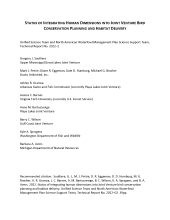
STATUS OF INTEGRATING HUMAN DIMENSIONS INTO JOINT VENTURE BIRD CONSERVATION PLANNING AND HABITAT DELIVERY
Unified Science Team and North American Waterfowl Management Plan Science Support Team, Technical Report No. 2022–2
EXECUTIVE SUMMARY
Conservation social sciences—the human dimensions (HD) of conservation—encompass a variety of issues and disciplines related to how people think about natural resources and the factors influencing related human behaviors. Recent revisions of the North American Waterfowl Management Plan (NAWMP) and Partners in Flight (PIF) landbird conservation plan include an explicit emphasis on people. Traditionally focused on regional biological planning and habitat delivery, migratory bird Joint Ventures (JVs) are at various stages of using HD in their work to further the goals of continental bird plans and to increase the effectiveness of JV conservation work. The intent of this assessment was to document status and approaches to HD integration among JVs and to provide experiential insights to the bird conservation community regarding this new challenge. Specifically, we wanted to determine the extent to which JVs are engaged in HD and are integrating people-related goals and objectives into bird conservation planning and bird habitat delivery. Further, we explored HD assumptions made by JVs, as well as challenges, barriers, and needs for expanded HD integration.
During early 2021, we contacted JV coordinators regarding a 2-phased study approach to determine application and integration of HD in their regional bird habitat planning and conservation delivery. All JV coordinators responded positively to the invitation, including 22 habitat JVs and two species-focused partnerships. The first phase of the assessment was an online survey with questions related to available HD expertise, past HD use, current HD interest and barriers to use, common people-related assumptions, and the value placed on HD in JV planning efforts. The second phase of the assessment included semi-structured interviews of the JV coordinator and, in some cases, additional JV staff invited by the coordinator to participate. These 2-hour discussions covered many of the topic areas included in the online survey, allowing JV representatives the opportunity to elaborate on their HD experiences.
Our results revealed that the JV community is keenly aware of the social and environmental change occurring in North America and the importance of using social science expertise to understand humans within the landscapes where they work. Joint Ventures largely recognized that future conservation focus must include birds, habitats, and people. However, respondents cited JV traditions and culture, partnership composition, regional landscape characteristics, and especially JV staff capacity as major factors limiting their ability to manage HD integration. The level of HD engagement by JVs generally fell into one of three groups: 1) no work yet, 2) used available data and literature to better target conservation, develop models, or learn about landowner decision-making, and 3) collected HD data with existing staff or through support from outside researchers and used results in conservation decisions. JVs were at various stages of conservation planning, and some implementation plans lacked HD emphasis simply because they were outdated. Although one JV had established an explicit HD objective for waterfowl hunter abundance, most JVs viewed conservation social science primarily as a means to serve a biological goal. The idea that quantifiable HD objectives would be established alongside quantifiable bird or habitat objectives was largely absent from JV responses. Although focus on people objectives is highlighted in the 2012 and 2018 NAWMP, JVs at this point are using HD science primarily to help achieve biological goals.
Adding social science expertise may be the highest near-term priority for many JVs. This proficiency can help identify how various regional stakeholders perceive the bird conservation community while also evaluating barriers and motivations to conservation activities, all of which are important for enhancing JV programs and communications. We found that seven JVs have staff members with at least some formal training in conservation social science, with one JV recently adding a second HD specialist to their staff. Another JV, lacking HD expertise within their staff, recently recruited a social scientist to their JV Technical Committee. The 2-phased approach used for this assessment was time-consuming to develop and manage, but we believe information reported here provides valuable HD guidance and an important baseline against which to measure progress. Examples and prospects for expanding HD in JV conservation programs are provided.
